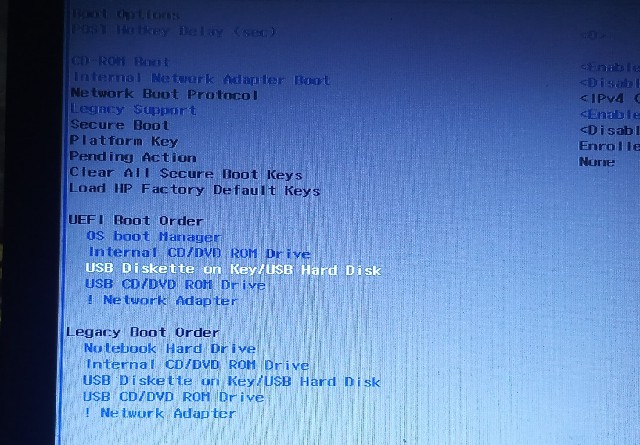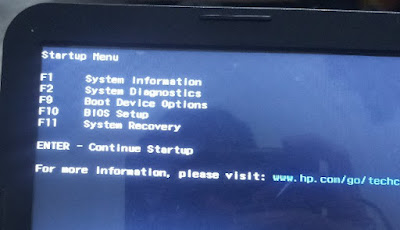1) Change the Bios sequence on the laptop
In most cases, the BIOS is usually not automatically set up for your computer. If you miss this stage and The machine periodically boots from your hard drive instead of getting boot details from your USB card.
Another note:
I'm trying to figure out how to boot from USB Hp laptop? After updating the BIOS list
Boot info with sequential priority, your PC will search for new boot info each time you restart your laptop.
It will help if you update your computer to the new settings, it won't cause the problem
Unless you plan to leave the bootable USB device permanently in the computer.
2) How to enable boot options in HP
Before installing a new device, you should backup your important data on any external drive or online cloud storage before installing a new OS on the laptop or just install the OS on the C: drive. Do not touch other drives to prevent Data is lost during installation.
So here we address all your questions and link to more articles on a similar topic.
Let's start with these simple steps.
Step 1: Turn on the laptop.
Step 2: Quickly hit the F9 key to open the boot menu or boot device options
Step 3: Unable to boot from USB or DVD drive in the boot menu. So now we must first allow Startup options.
Step 4: Press the F10 button to enter the Bios configuration.
Step 5: Enter System Setup in BIOS. Then go to bootstrap and join.
Step 6: Now, here you can see the old disabled support.
Step 7: Trigger this action and press Enter. Then press yes. Then press yes.
Step 8: We're done here. Now remove your bootable USB drive from Windows 10.
3) Prepare a bootable Windows 10 USB drive
To use a Windows 10 USB drive, users who want to boot an HP laptop need to prepare a bootable USB drive.
1. Insert the USB drive into a laptop or computer with an installed operating system.
2. Now download and open the Windows Media Development App.
3. Read and approve the license.
4. The user should then select the installation media option and click Next.
5. Gather the languages and proceed to select the USB drive as the media.
6. Select the U disk and wait for the operating system to be successfully downloaded to the U disk drive.
4) Enable USB Client on any USB port on your PC
While it can appear that you can copy the file to the drive and do so, it's not exactly the case. You shall need to burn the ISO file to a USB drive first.
An ISO file or ISO image is just a box of multiple files and directories into a single file. they will always be File Extensions: ISO files are an easy way to copy entire programs and applications.
PLEASE NOTE: Make a bootable flash drive or learn how to boot from USB HP laptop External hard drives are another DIY job that can take some time to find.
5) Restart your computer
During this process, you will not change anything from within the operating system. this means
The restart process is very different. The BIOS should tell you what to press instead of the standard restart key.
For example, it could be F10, but follow your BIOS instructions to safely save changes in the boot order, then Restart your computer. Watch for the message "Press any key to boot from external device"
on your monitor.
The USB drive usually sends a message asking you to press a button before the USB driver can start the PC. if this occurs and you do not respond, the next boot option in the BIOS sequence order is verified by your PC. In most cases, your hard drive is the next option.
Note: When you boot from a USB drive, the keystroke message may not appear. it is usually a method
of self-starting.
6) Your USB drive should boot your PC
The next steps depend on the purpose of the bootable USB system. If you try from
Your USB device and you've done all the right things, the OS is easy to boot and get started
your device.
Expect this method to take about 10 minutes from start to finish.
7) Installing a new operating system doesn't have to be complicated.
You'll be taken to the Windows 10 operating system, which can be quickly booted using a USB drive
Correct equipment and details.
In some cases, you can even install the operating system from disk, but this is usually
Outdated installation process. USB drives provide a convenient option for software installation because they have higher storage capacity.
However, one argument is that the USB computer you plan to use should not have all the important files because After burning the ISO file, any current files will disappear. Before using it, make sure you save or return Create virtual cloud or external hard drive files.
If you're nostalgic for the old OS, you're in luck. The old and famous Windows 95 is still available on the internet. If your system is upgraded or uses a backup OS, a good OS will A difference in your machine.
FAQs - How to boot from a USB HP laptop:
1. How to open the boot device menu in an HP laptop to boot from USB?
To open the boot device menu, press F9. To select a USB flash drive, use the up or down arrow keys, and then press Enter. NOTE: If you cannot select the USB flash drive from the boot menu, Disable stable boot and BIOS legacy mode.
2. How do I force my laptop to boot from USB?
USB Boot: Windows
1) Press the computer's power button.
2) Press ESC, F1, F2, F8, or F10 in the initial initialization screen.
3) When you want to add BIOS settings, the configuration utility page will appear.
4) Using the keyboard's arrow keys, select the BOOT tab. There is an error.
5) First move the USB in the boot order.
3. How do I access the HP laptop boot menu?
Boot order configuration
1) Turn on the machine or restart the machine.
2) Click the Esc or f10 key when the view is blank to enter the BIOS menu.
3) On some computers, you can use the f2 or f6 keys to enter the BIOS setup menu.
4) Enter the boot settings after opening the BIOS. There is an error.
5) Follow the on-screen instructions to change the boot sequence.
In conclusion
If you have any questions about this guide on "How to boot from USB Hp Laptop,", let us know in the comments section below. and I will answer it quickly as possible.




